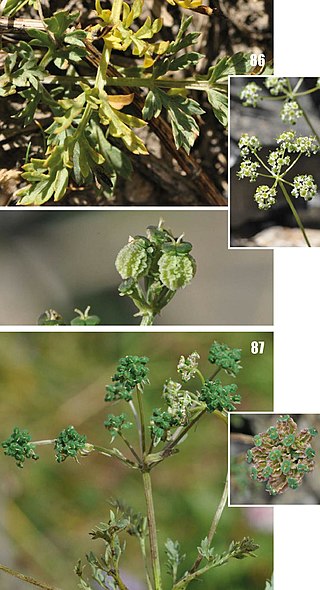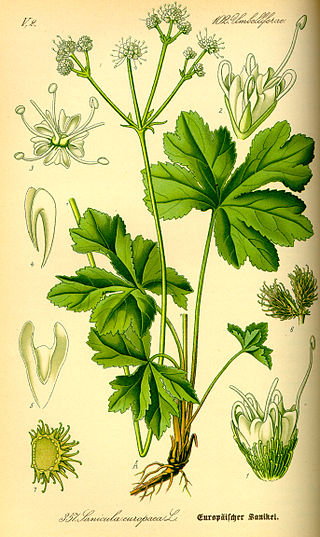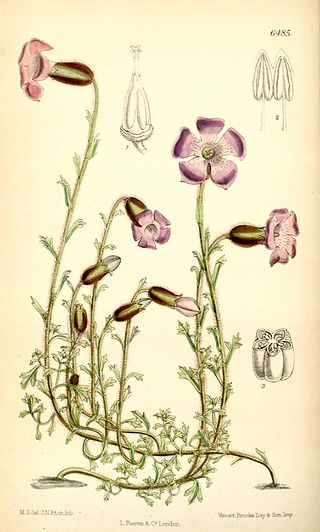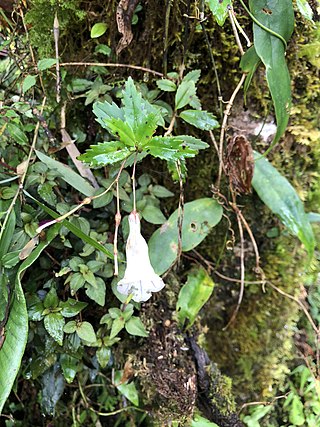
Gentiana is a genus of flowering plants belonging to the gentian family (Gentianaceae), the tribe Gentianeae, and the monophyletic subtribe Gentianinae. With over 300 species, it is considered a large genus. Gentians are notable for their mostly large trumpet-shaped flowers, which are often of an intense blue hue.

Honeysuckles are arching shrubs or twining vines in the genus Lonicera of the family Caprifoliaceae. It includes 158 species native to northern latitudes in North America, Eurasia, and North Africa. Widely known species include Lonicera periclymenum, Lonicera japonica and Lonicera sempervirens. L. japonica is a highly invasive species considered a significant pest in parts of North America, Europe, South America, New Zealand, Australia, and Africa.

Gentianaceae is a family of flowering plants of 105 genera and about 1600 species.

Androsace, commonly known as rock jasmine, is a genus of flowering plants in the family Primulaceae, second only to Primula in the number of species. It is predominantly Arctic–alpine, with many species in the Himalayas, the mountains of central Asia, the Caucasus, and the southern and central European mountain systems, particularly the Alps and the Pyrenees.

Nomocharis was a genus of flowering plants in the family Liliaceae. It consisted of about 7 species native to montane regions of western China, Myanmar, and northern India. They are similar to Lilium, with one of the more obvious differences being the flowers being more shallow or sometimes flat.

Aulacospermum is a genus of flowering plants in the family Apiaceae, with 15 accepted species. It is endemic to Central Asia and Eastern Europe.
Chamaesium is a genus of flowering plant in the family Apiaceae. It contains ten species native to the Himalayas and central China.

Sanicula is a genus of plants in family Apiaceae, the same family to which the carrot and parsnip belong. This genus has about 45 species worldwide, with at least 22 in North America. The common names usually include the terms sanicle or black snakeroot.

Ajania is a genus of flowering plants in the daisy family, described as a genus in 1955. The genus is native to temperate Asia, primarily Russia and China. It is named after the Russian port city Ayan in the Khabarovsk Krai region of the Russian Far East, on the coast of the Sea of Okhotsk.

Cyananthus is a genus of flowering plants that includes 21 species of annual or mostly perennial herbs from high mountains of Central and East Asia. They are little Himalayan plants no higher than 4 in. The name comes from the Greek word for blue flowers. Leaves are usually small and simple, sometimes narrowing to base, tooth-lobed at summit. In August to September, the plants bear showy of bright purplish-blue, yellow or white, funnel to bell-shaped, 5-lobed flowers 1 in in diameter with stamens free from the corolla and hairy throat. The flowers are borne singly on stalks. They always lose the aerial parts during the coldest months, and as spring begins, stems and leaves quickly start to reproduce.

Rhododendron selense (多变杜鹃) is a rhododendron species native to southwestern Sichuan, eastern Xizang, and western Yunnan in China, where it grows at altitudes of 2,700–4,000 m (8,900–13,100 ft). It is an evergreen shrub that grows to 1–2 m (3.3–6.6 ft) in height, with leaves that are oblong-elliptic or obovate to elliptic, 4–8 by 2–4 cm in size. The flowers are pink.

Micranthes is a genus of flowering plants in the saxifrage family. It was formerly included within the genus Saxifraga until recent DNA evidence showed the members of what is now Micranthes are more closely related to Boykinia and Heuchera than to other members of the genus Saxifraga.

Lonicera ligustrina, the privet-like honeysuckle, is a species of honeysuckle found in the central and eastern Himalayas of Bhutan, India, Nepal, and in southern and central China. It grows as an evergreen, semi-evergreen, or deciduous shrub approximately 1.5-2.5 meters in height, with leathery or paper-like leaves 0.4-8 × 0.2-1.5 cm in size.

Lysionotus is a genus of flowering plants in the family Gesneriaceae. It occurs in the Himalayas, China, Japan, and Southeast Asia. The genus was described by David Don in 1822.
Crawfurdia is a genus of flowering plants belonging to the family Gentianaceae.

Omphalogramma is a genus of flowering plants belonging to the family Primulaceae.
Hymenidium is a genus of flowering plants belonging to the family Apiaceae.
Kuepferia is a genus of flowering plants belonging to the family Gentianaceae.
Metagentiana is a genus of flowering plants belonging to the family Gentianaceae.













